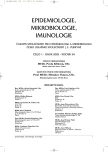Disribution of Streptococcus pneumoniae Serotypes and Serogroups Among Patients with Invasive Pneumococcal Diseases in the Czech Republic in 1996–2003: Background Data for Vaccination Strategy
Distribuce sérotypů a séroskupin Streptococcus pneumoniae u pacientů s invazivními pneumokokovými onemocněními v České republice v letech 1996–2003: podklady pro vakcinační strategii
Cíl práce:
Zjistit distribuci sérotypů a séroskupin S. pneumoniae v České republice (ČR) v období 1996–2003 jako podklad pro účinnou aplikaci typově specifické pneumokokové konjugované vakcíny.
Metody:
Sérotypy byly určovány technikou bobtnání pouzder (Quellung) pomocí sér ze Statens Serum Institutu (Dánsko) u 1553 kmenů S. pneumoniae izolovaných v ČR od pacientů s invazivními pneumokokovými infekcemi (IPO).
Výsledky:
V klinických vzorcích (krev, likvor, sekční materiál, punktát a aspirát dolních dýchacích cest, bronchoalveolární laváž, sputum) získaných od pacientů s IPO patřily k nejčastějším kmeny sérotypů 3, 19F, 9V, 23F, 1, 14 a 4. Mimo typy společné pro kmeny izolované od pacientů všech námi zvolených věkových kategorií (1, 3, 6A, 9V, 14, 19F a 23F), patřily navíc mezi nejčastější u pacientů 0–2 roky sérotyp 6B, u pacientů >2–5 let sérotypy 4, 6B, 7F a 18C a u pacientů >5 let typy 4, 7F, 8, 9N, 10A a 11A. Pneumokoková konjugovaná 7valentní vakcína (PNCRM7) pokrývá 63,1 %, 62,3 % a 34,3 % sérotypů identifikovaných u 152 pacientů 0–2 roky, resp. 168 pacientů >2–5 let, resp. 1233 pacientů >5 let věku. Zahrnuje 38,3 % sérotypů zjištěných u 1055 kmenů izolovaných z krve, likvoru a sekčního materiálu od pacientů bez rozdílu věku. Ve sledovaném období vzrostlo procento kmenů obsahujících některý ze sérotypů zahrnutých ve vakcíně ze 45,5 % na 70,6 % u pacientů 0–2 roky, z 54,3 % na 38,7 % u pacientů >2–5 let a z 21,8 % na 38,7 % u pacientů starších 5 let; z 30,0 % na 39,4 % u kmenů izolovaných z krve, likvoru a sekčního materiálu. Analogický trend byl zjištěn i při sledování prevalence séroskupin. Na tomto posunu má podíl i plynulý nárůst kmenů sérotypů 4 (z 1,0 % na 8,9 %) a 9N (z 0,0 % na 5,9 %).
Závěr:
Přestože je účinnost PNCRM7 omezena nízkým zastoupením vakcinačních sérotypů určených v ČR u kmenů izolovaných od pacientů s IPO, je možné ji k aplikaci a podání doporučit. Výsledky dlouhodobého monitorování distribuce sérotypů v ČR však prokazují nezbytnost budoucího rozšíření jejího současného spektra o antigeny typů 1 a 3.
Klíčová slova:
pneumokoky – sérotypy – séroskupiny – infekce – pneumokoková konjugovaná vakcína.
Authors:
J. Motlová
Authors‘ workplace:
Centrum epidemiologie a mikrobiologie, SZÚ Praha
Published in:
Epidemiol. Mikrobiol. Imunol. 54, 2005, č. 1, s. 3-10
Overview
Study objective:
To map distribution of Streptococcus pneumoniae serotypes and serogroups in the Czech Republic in 1996–2003 in order to provide background data for effective strategy of vaccination with type specific pneumococcal conjugated vaccine.
Methods:
Quellung typing with sera from the Statens Serum Institute (Denmark) was used to differentiate 1553 S. pneumoniae strains isolated from patients with invasive pneumococcal infections in the Czech Republic.
Results:
Strains of serotypes 3, 19F, 9V, 23F, 1, 14 and 4 were most frequently isolated from clinical specimens (blood, cerebrospinal fluid, autopsy specimens, lung puncture aspirate, bronchoalveolar lavage fluid, sputum) of patients with invasive pneumococcal infections. Some serotypes were detected regardless of patient age (1, 3, 6A, 9V, 14, 19F and 23F), while serotype 6B was most frequent in the age group 0–2 years, serotypes 4, 6B, 7F and 18C were typically found in the age group >2–5 years and types 4, 7F, 8, 9N, 10A and 11Awere common in patients aged >5 years. The 7-valent conjugated pneumococcal vaccine (PNCMR7) covers 63.1 %, 62.3 % and 34.3 % of the serotypes identified in 152 patients aged 0–2 years, 168 patients aged >2–5 years and 1233 patients aged >5 years, respectively. It includes 38.3 % of the serotypes identified among 1055 strains isolated from blood, cerebrospinal fluid and autopsy specimens regardless of patient age. Over the period monitored, the percentage of strains allocated to one of the serotypes included in the vaccine increased from 45.5 % to 70.6 %, from 54.3 % to 38,7 % and from 21.8 % to 38.7 % in patients aged 0–2 years, >2–5 years and >5 years, respectively, and from 30.0 % to 39.4 % for the isolates from blood, cerebrospinal fluid and autopsy specimens. A similar trend was found in the distribution of serogroups. These shifts can also be ascribed to the continuous increase in the percentages of strains of serotypes 4 (from 1.0 % to 8.9 %) and 9N (from 0.0 % to 5.9 %).
Conclusion:
The PNCRM7 vaccine is recommended for use in the Czech Republic in spite of the lower prevalence of vaccination serotypes among strains isolated from Czech patients with invasive pneumococcal infections which is a limitation to its efficacy. Nevertheless, results of the longterm monitoring of serotype distribution in the Czech Republic are suggestive of the need for inclusion of types 1 and 3 in the vaccine in the future.
Key words:
pneumococci – serotypes – serogroups – infections – conjugated pneumococcal vaccine
Labels
Hygiene and epidemiology Medical virology Clinical microbiologyArticle was published in
Epidemiology, Microbiology, Immunology

2005 Issue 1
Most read in this issue
- Inhibition of Hemolytic Activity of Staphylococcus aureus β-hemolysin by an Exosubstance Produced by some Enterococcus faecalis Strains
- HCV Genotyping by Combination of Cobas Amplicor HCV 2.0 Test and Versant HCV Genotype Assay
- Longitudinal Epidemiology of Leptospirosis in the Czech Republic (1963–2003)
- Poliomyelitis Surveillance in the Czech Republic from the Start of Vaccination to the Certification of Eradication in the European Region
